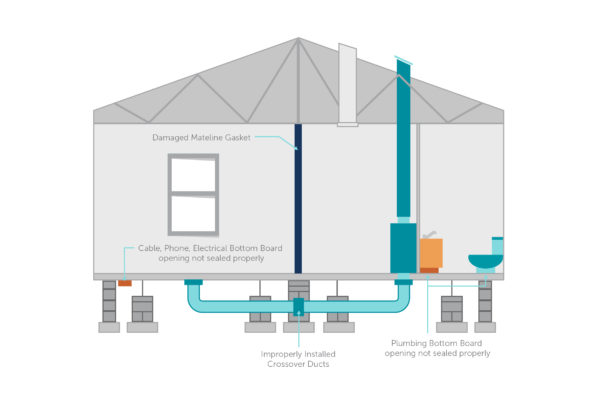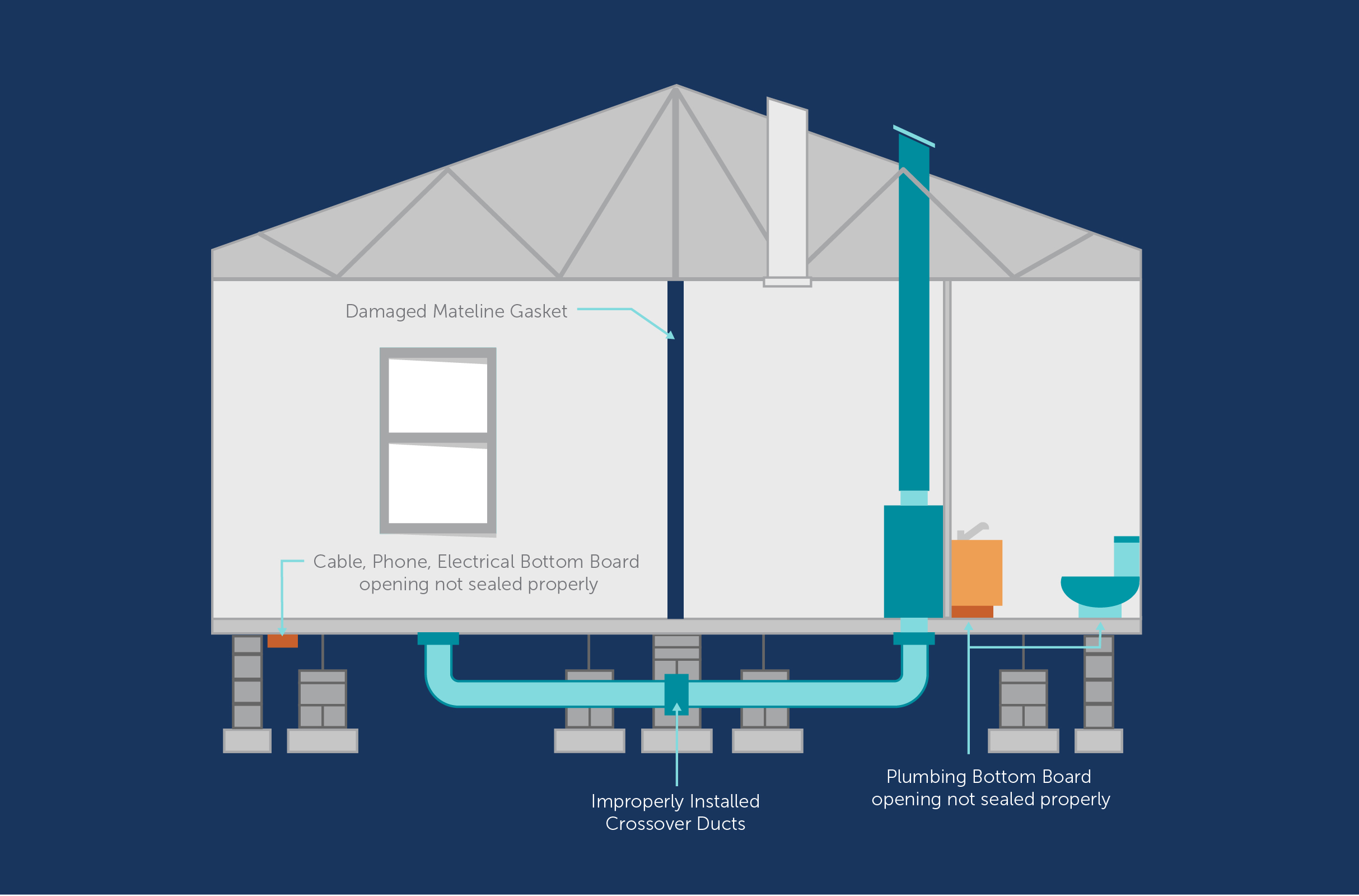In many cases, when homeowners report that their home is not cooling, contractors often blame the size of the air conditioning unit. However, air infiltration is often the actual issue.
According to the North American Insulation Manufacturer’s Association (NAIMA), air infiltration or air leakage contributes up to 35% of heat loss in a home1. An estimate by the EPA2 shows that air infiltration contributes to 25% to 40% of the energy used for cooling and heating a home.
Manufactured Homes reduce air infiltration by tightening a home’s envelope using products like house wraps, foams, tapes, sealants, and gaskets.
A home’s thermal envelope is a barrier that separates the unconditioned environment from the conditioned air. The envelope helps provide resistance to air, water, light, heat, and noise transfer. However, insulation is not effective in preventing air infiltration or air leakage.
In hot humid months, air infiltration can cause high humidity levels to rise even further. Air conditioning will draw in warm, humid air through the leaky areas of a home. This means more discomfort to homeowners and higher utility bills.
So, where does air leakage or air infiltration commonly occur?
Improperly installed crossover ducts.
A crossover duct that is not installed properly allows conditioned air to leak outside the home. As a result, the thermostat fails to reach the correct temperature setting. To make things worse, the HVAC system will supply the lost air by drawing in outside air through leaks and gaps.
Making it Right – Take these steps to properly install crossover ducts:
- Apply mastic completely over the inner liner and collar or V-box. Slide the crossover duct inner liner over the crossover collar or V-box as far as it will go. Next, install a large nylon zip tie over the inner liner just above the “ridge” around the crossover collar. Apply mastic completely over the inner liner and collar.
- Bring the duct insulation up over the zip tie and above the home’s bottom board into the floor cavity. Temporarily duct tape it against the base of the trunk duct.
- Pull the crossover duct outer wrap over the top of the insulation and temporarily secure it to the trunk duct/V-box with duct tape.
- Feel for the nylon zip tie that was installed over the inner liner. Place another nylon zip tie just under the first one to permanently secure the crossover duct insulation and outer wrap, making sure all of the insulation is inside the outer wrap.
- Trim the crossover duct to length. Install the other end using the steps listed above. Seal the joint between the duct work and bottom board. Support the crossover duct at least every 48 inches.
Damaged mateline gasket
Incorrect installation of the home sections may not provide the proper compression of the mateline gasket, which can prevent the gasket from acting as a barrier against air and moisture infiltration. If the mateline gasket is damaged, an air gap could occur, which is just like leaving a window partially open.
Making it Right – Three Major Tips:
- Inspect gaskets for damage prior to connecting home sections.
- Remove damaged gasket sections and replace with a
new gasket. - After the home sections are connected inspect and repair damaged gasket sections according to the manufacturer’s Site Construction Manual or Installation Manual.
Bottom board that is not sealed properly
Multi-sectioned homes have openings in the bottom board as a result of lag screws, HVAC connections, plumbing connections, etc. Not to mention the openings created by contractors for satellite, phone, cable, etc.
Making it Right – Three Tips to Ensure a Proper Seal:
- Follow all electrical, communication/data lines, HVAC, and plumbing connections to the bottom board. Inspect the bottom board for openings.
- For smaller repairs, fasten a small patch of bottom board material with spray adhesive and tape around fastener holes.
- For larger repairs, fasten bottom board material with spray adhesive, tape around fastener holes, add furring strips and attach to joists to prevent the patch from coming loose over time. Ensure the bottom board patch is large enough to extend past plumbing and ductwork to allow space to attach the furring strip.

Unrepaired openings in the bottom board or gaps in the mateline will allow warm, humid outside air to enter into the living space of a home. In addition, warm, humid air that enters a home through the unrepaired bottom board or mateline gaps condenses once it comes in contact with cold, dry conditioned air. Moisture generated by this condensation can damage building materials and often lead to more problems down the line.
1. https://insulationinstitute.org/wp-content/uploads/2016/02/BI480.pdf
2. https://www.energystar.gov/newhomes/explore_features_benefits
